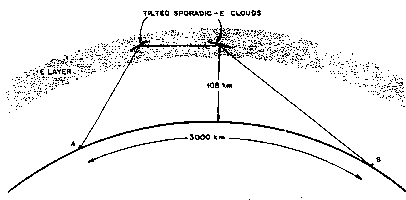

home > archive > propagation theory > a primer on sporadic-E
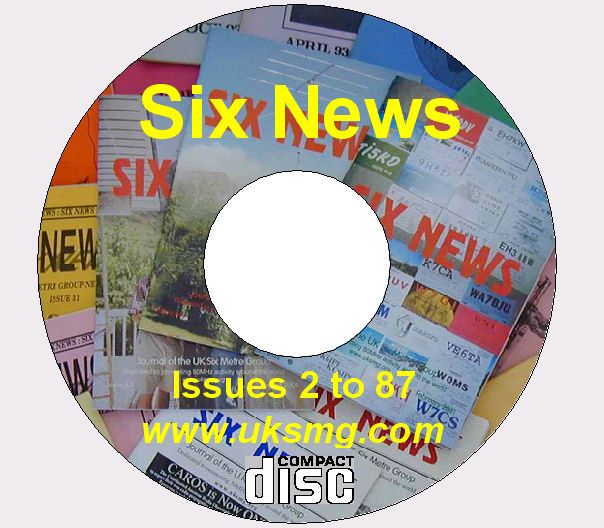
Thanks to all of our authors since 1982!
|
sporadic-E propagation
at VHF |
|
|
Thousands
of spectacular sporadic-E contacts made on the 50, 144,
and 220-MHz bands during the past half dozen years have
created considerable excitement in VHF circles. US and
Canadian 6-meter operators have long awaited the
opportunity to make 50-MHz E-skip contacts into Europe,
and the first two-way transatlantic 50MHz sporadic-E
contacts were made on July 11 1983, soon after British
amateurs gained access to the band. Most of the British
stations that made 5000km and longer contacts were
running only a few watts! Since then many stations in
Canada, on the East Coast and in the South and Mid West
have been treated to European sporadic-E openings.
Similar contacts between the East Coast and Hawaii (up
to 8000km) and the West Coast to Japan (7600km and
longer) are frequent enough to suggest even greater
possibilities for 6-meter sporadic-E. What is Sporadic E?Sporadic-E (also known as Es) propagation is probably familiar to many low-band operators as the summertime "short skip" on 10 meters. It is also responsible for most of the long-distance (600km and greater) contacts on the 6-meter band. Sporadic-E is a type of ionospheric E-layer reflection caused by small patches of unusually dense ionization. These sporadic E-layer "clouds" appear unpredictably, but they are most common over the US and southern Canada during the daylight hours of late spring and summer. Sporadic-E events may last for just a few minutes to several hours; a given event usually affects only small areas of the country at any one time. During June and July, signals propagated by means of sporadic-E ionization may be heard on 50MHz for several hours a day on more than half the days. Sporadic-E is observed on 144 MHz less than a tenth as often as on 50MHz. Signals are often remarkably strong, allowing 50 and 144MHz stations running 10 watts, and often much less than that, to make contacts 1500 km and longer with relative ease. Phenomena related to Sporadic E Other closely related propagation modes are sometimes confused with temperate-zone sporadic-E. Long duration meteor scatter is often difficult to distinguish from true sporadic-E. When the MUF is just below 50MHz, for example, random meteors may elevate the MUF to a useful level for a few tens of seconds at a time. At times, such scatter simply evolves into solid sporadic-E propagation and may serve as an early warning of E-skip conditions. During especially intense sporadic-E sessions, -scatter may be evident. -scatter signals are much weaker than normal E-skip signals; they may exhibit multipath flutter (a hollow, from-the-bottom-of-a-barrel sound) or have a slight echo. -scatter signal paths are usually well off expected great-circle bearings, but focus on known sporadic-E reflection centers. The expected communication range via -scatter is short (in the 300 to 1100km range); thus, back-scatter may be useful for making contacts between the normal tropo distance and the shortest E-skip distances. Back-scatter contacts maybe especially useful in "filling n" grid-square multipliers on 50MHz during contests, for example. Back-scatter has been observed on 144 MHz when the MUF was in that range. Field-aligned irregularities (FAI) is a newly discovered propagation mode that may exist simultaneously with sporadic-E and persists for an hour or more after all evidence of normal sporadic-E has disappeared. FAI signals are generally very weak and may easily be confused with back-scatter signals. Signals propagated by means of FAI have a rough, auroral quality; because of this SSB communication via FAI may be marginal at best. To make use of FAI, operators generally must point their antennas northward - as is necessary with auroral propagation - toward an existing or former sporadic-E center. Distances up to 2000km have been reported for FAI work at 144 MHz. Intense auroral propagation that spontaneously evolves into sporadic-E in the northern latitudes of the US and Canada is known as auroral-E propagation. Sometimes this shift takes place over the course of a minute and may be evident during a single contact. A rough, raspy, auroral signal may be quickly transformed into a strong, crystal clear signal. When this happens, auroral-E has taken over. Another characteristic of auroral-E is that it sometimes supports communication over distances much greater than would be expected for other types of sporadic E (up to 3200km), because auroral-Es clouds are typically higher than temperate-zone clouds. Commonly observed auroral-E paths include Alaska, the Yukon and the Northwest Territories to the upper US Midwest and New England. Auroral-E is observed far less often than temperate-latitude sporadic E and primarily on the 50MHz band. Geographical, Seasonal and Daily Variations The appearance of sporadic-E is related not only to time of day and to season, but to geographical location. Researchers have identified five distinct geographic zones of sporadic-E occurrence based primarily on seasonal and hourly characteristics. These zones are shown in Fig 1. Within the northern temperate zone, sporadic-E may appear at any time, but long-term observations have shown that it occurs more often from mid-May to mid-August than any other months, followed by a less productive period from mid December to mid-January. Mid-latitude sporadic-E also occurs most often from 0800 to 1200 and 1900 to 2300 local time, regardless of season, with a statistical peak at about the midpoint of each time period. The daily and seasonal probabilities of sporadic E over the US from May through August are shown graphically in Fig 2. There are also significant variations within the northern temperate zone. Sporadic-E ionization occurs most often in the western Pacific, China and South-east Asia, and least often over the north Atlantic and adjacent portions of the north-eastern North America! In the US, E-skip is nearly twice as common over the South-west as over the North-cast. Peak times for sporadic-E in the rest of the world vary considerably. Like that of the northern temperate zone, the major sporadic-E season in the southern temperate zone occurs from late spring to early summer (mid-November to mid-February in the southern hemisphere). In the two auroral zones, sporadic E is a nearly constant phenomenon of the 8-hour period centered at noon regardless of the season, but it is rare at other times. In the two auroral zones, sporadic E is least likely to appear at noon, but it appears more than half the time in the 1800 to 2400 period with little variation throughout the year. E-Skip and Solar Activity The
relationship between the formation of temperate-zone
sporadic-E and solar geophysical conditions are still
debated. Most researchers have held that there is no
clear correlation between the sunspot cycle and
sporadic-E formation that compares with close
association between F-layer and solar conditions. Some
recent work has suggested that this may not be the case,
and that low solar activity, whether measured as solar
flux (sunspot number) or short term geomagnetic
conditions (planetary A and K indexes), are most
favourable for temperate-zone sporadic-E formation. Causes of Sporadic E The cause or more likely the multiple causes of sporadic-E are still being pursued by researchers. Ten distinct types of sporadic-E, and at least nice different theories of causation, were listed in the review of what was known about sporadic-E in 1959. The classification of distinct types has been retained, but since the 1960s, the wind shear theory has gained more acceptance than any other in explaining temperate-zone sporadic-E formation. In its simplest form, the windshear theory holds that gaseous ions are accumulated and concentrated into small, thin, patchy sheets by the combined actions of high-altitude winds and the earth's magnetic field in the E region of the ionosphere. The resulting sheets, or sporadic E clouds, may attain the required ion density to serve as a reflecting medium for VHF radio waves. Recent work has emphasized the role of long lived ion and magnesium ions (thought to be the result of meteor evaporation) in the formation of sporadic E clouds. Sporadic E clouds observed by rocket-borne instruments and back-scatter experiments have been found to be 50 to 100km in diameter, 2 to 4 km thick and 95 to 115km in altitude. The results of one such rocket experiment are shown in Fig 5. Although most research has confirmed a close association between wind-shear and sporadic E, not all aspects of the sporadic-E phenomenon can be explained, including its diurnal and seasonal variations. The Classical 'E' Skip Model The wind-shear theory is consistent with classical description of temperate-zone E skip derived from observations of amateur VHF communications and specially designed experiments. In the classical model, sporadic-E reflections are assumed to be specular (mirror-like) and associated with a single E cloud that lies midway along a given radio path at an altitude of about 105km. See Fig 6. At this altitude the maximum possible single-reflection (single hop) distance computes to about 2200 km, The highest frequency reflected back to the surface of the earth, the MUF, varies from 20 MHz to at least 220 MHz. At the MUF, the angle of reflection is greatest, the single-hop distance is longest and signal strengths are greatest. As the signal frequency decreases from the MUF, the angle of reflection decreases, the resulting signal path is shorter and signal strength is relatively less. At some critical frequency signals transmitted straight up will be reflected straight down (zero angle of reflection). The classical model also describes a relationship among MUF, signal frequency, angle of radiation and resulting path distance that can serve as a very useful tool for quick evaluation of sporadic-E conditions. These relationships are presented in Fig 7 and can be calculated more precisely if desired. The minimum MUF of a single sporadic-E reflector can be determined when the frequency and path distance of any observed contact are known. Consider a
50MHz contact between stations in Memphis and
Indianapolis, 600 km apart, shown in Fig 8. What is the
minimum possible MUF of the cloud that is supporting
that path? Refer to Fig 7 and read up from 600km until
you reach the dashed line corresponding to 50MHz. Then
find the MUF by interpolating between the solid curves
for 144 and 200MHz. In this case, the MUF is something
over 144MHz - say, 160MHz. The process can be taken one
step further to estimate the likely distance that could
be spanned on 144MHz using the same E cloud as a
reflecting point. Follow the imaginary 160MHz MUF line
up and to the right until it intersects the dashed line
that corresponds to a signal frequency of 144 MHz. This
intersection corresponds to 1800 km on the horizontal
scale. Such an analysis strongly suggests that a 144MHz
path from Minneapolis to Tallahassee or any other 1800km
path with the same center point - should be possible.
Fig 7 also reveals another curious relationship: the MUF
is about 5.3 times the critical frequency (zero on the
horizontal distance scale). Multiple-Hop Paths and Other Complications The
classical model may help to explain single-hop paths,
but what about sporadic-E contacts longer than 2200 km -
the maximum single-hop distance (assuming an Es-layer
altitude of 105km)? The classical model requires that
such paths be completed by hops via at least two E
clouds spaced at just the right distance to complete the
path. Further, each cloud must exhibit the necessary
MUF. Longer paths, such as those from the East Coast to
Europe or even from the Midwest to Hawaii, require an
even trickier cloud arrangement because at least three
hops are necessary to complete them. Some participants in 144 MHz contacts in the 2800 to 3200 km range have heard or worked stations at intermediate distances. This is evidence that multiple hops may be responsible in such situations. In other cases, there has been no evidence of intermediate hops. Lack of such evidence does not preclude the existence of intermediate hops, of course. In some cases, it has been argued that there were simply no stations active at intermediate distances. There are
other possible explanations for sporadic-E propagation
beyond the one hop range. Sporadic-E clouds higher than
110 km could support contacts over longer distances (a
cloud at an altitude of 150km would lengthen the
single-hop range to 2500 km), but there is little
evidence that sporadic-E clouds form at altitudes higher
than 120km. E-skip paths may be lengthened by extended
tropospheric enhancement or unusually high station
elevation at one or both ends of the path, but it is
unlikely that these factors explain more than a few
particular cases. Prospects A 220MHz E-skip contact has
been completed, and three and four hop 50MHz contacts
are common enough to no longer be surprising. What is
left to achieve? It is apparent that a transcontinental
144MHz contact is possible. The claimed 144MHz distance
record of 3865km is greater than the distance from Los
Angeles to Charleston, for example. On June 14, 1987,
the North American continent was nearly spanned on 144
MHz when James Fry, NW7O/7, in Southern Nevada, hooked
up with James Poore, KD4WF, Savannah, Georgia - a
distance of 3165km. Undoubtedly, an actual trans-North
American 144 MHz contact will be completed in the near
future. Back
UKSMG Six
News issues
40 & 41,
Jan & April 1994
|
WWV
numbers and F2
D-layer
ionoscatter on 50MHz
monitoring 30-50MHz across the pond
E-layer and sporadic-E prop.
the
solar myth
the
doughnut effect
winter transatlantic E's
troposcatter at 50MHz
50MHz sporadic-E in 1996
cometary origin of sporadic-E
rattling old bones about sporadic-E
doppler analysis of 6m signals
tropospheric prop. at 50MHz
50MHz prop. between Africa and
Europe 1998
analysis of 50MHz contacts between VK and EU
hidden mode of sporadic-E?
a crtique of 'hidden mode of
sporadic-E?'
6m
scatter DX
SV1DH
to PY5CC with 1mw
equatorial propagation
50MHz
F2 prop. mechanisms
more
on 50MHz F2 prop.
observations on Skew-path DX from FM18
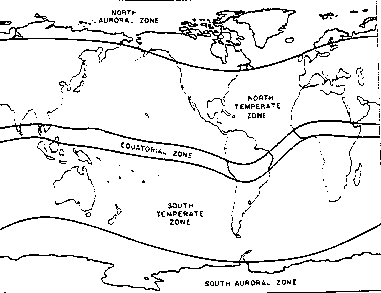
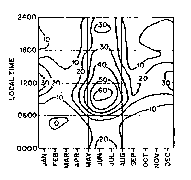 Fig
2: Average occurrence of sporadic-E in the Northern
temperate zone as a percentage of time. The curves on
this graph are line of constant percentage. Note that
the peak period for sporadic-E is 0900 to 1100 during
June and July.
Fig
2: Average occurrence of sporadic-E in the Northern
temperate zone as a percentage of time. The curves on
this graph are line of constant percentage. Note that
the peak period for sporadic-E is 0900 to 1100 during
June and July. 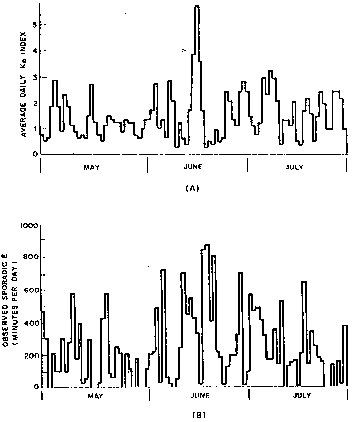 Fig 3: A comparison of
average planetary K index (Kp) values (A) and observed
daily minutes of sporadic-E signals heard on 50MHz (B)
during 1965.
Fig 3: A comparison of
average planetary K index (Kp) values (A) and observed
daily minutes of sporadic-E signals heard on 50MHz (B)
during 1965. 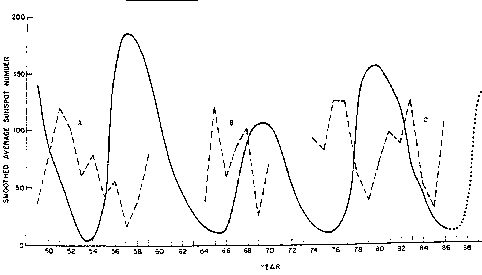
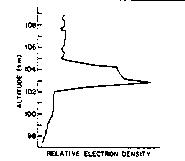 Fig 5: Electron density
as a function of altitude across a sporadic-E cloud.
Based on the results of an Aerobee rocket flight in
May 1962.
Fig 5: Electron density
as a function of altitude across a sporadic-E cloud.
Based on the results of an Aerobee rocket flight in
May 1962. 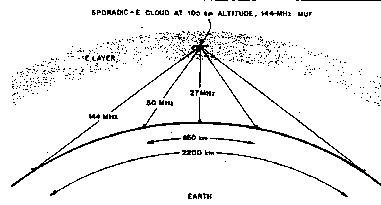
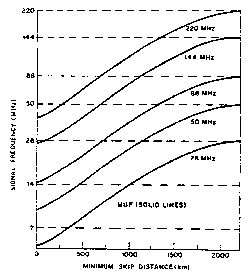 Fig 7: Relationship between
path distance, frequency and MUF for signals
propagated by means of sporadic-E clouds at an
altitude of 105 km.
Fig 7: Relationship between
path distance, frequency and MUF for signals
propagated by means of sporadic-E clouds at an
altitude of 105 km.
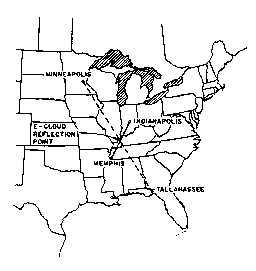 Fig
8: A 50MHz E-skip contact between Indianapolis and
Memphis (600 km) suggests the existence of a
sporadic-E reflection point over western Kentucky (at
mid path).
Fig
8: A 50MHz E-skip contact between Indianapolis and
Memphis (600 km) suggests the existence of a
sporadic-E reflection point over western Kentucky (at
mid path). 